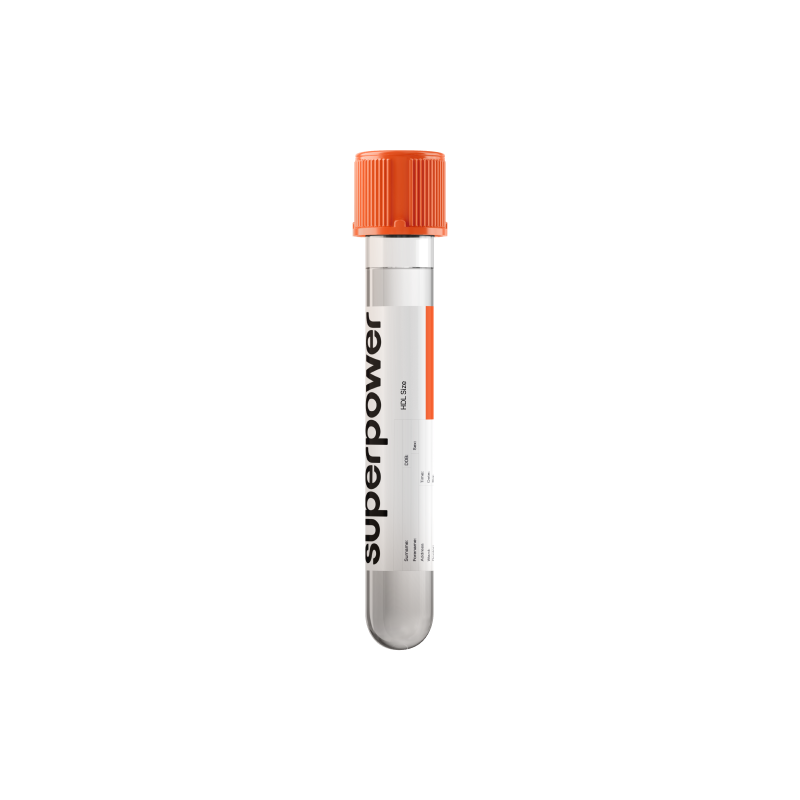HDL Size testing goes beyond HDL cholesterol (HDL-C) to show the actual quality and behavior of HDL particles. Smaller HDL particles often travel with high triglycerides and insulin resistance, while larger particles tend to indicate more efficient lipid transport.
By measuring HDL Size, you gain a clearer view of whether your HDL is protective or compromised, and how nutrition, exercise, hormones, and medications are shaping your lipid profile over time.
Key Benefits
- See whether your HDL particles are larger, more protective types or smaller, less protective.
- Spot an atherogenic imbalance linked to insulin resistance, high triglycerides, and metabolic syndrome.
- Clarify hidden heart risk when HDL cholesterol looks normal but particles run small.
- Guide lifestyle focus toward lowering triglycerides to enlarge HDL size and improve function.
- Inform treatment priorities by focusing on lowering ApoB/LDL and triglycerides, not raising HDL.
- Track response to exercise, weight loss, and carb reduction as HDL size rises.
- Explain how smoking or inflammatory conditions can shrink HDL and blunt protection.
- Best interpreted with standard lipids, ApoB or LDL-C, triglycerides, and insulin resistance markers.
What is HDL Size?
HDL size is the average diameter of the high-density lipoprotein particles in your blood. These particles are lipid-protein packages built around apolipoprotein A-I (apoA-I), assembled by the liver and intestine and then remodeled in the bloodstream. They start as tiny, flat “nascent” discs and become spherical as they pick up cholesterol and convert it to cholesterol esters via LCAT (lecithin-cholesterol acyltransferase). Size is further shaped by lipid transfer proteins (CETP) and lipases (hepatic and endothelial lipase).
HDL size is a snapshot of HDL maturation and cargo. Larger particles indicate HDL that has accumulated cholesterol esters and undergone more remodeling; smaller particles reflect earlier-stage, cholesterol-poor HDL. Size matters because it relates to what HDL can do: accept cholesterol from cells (reverse cholesterol transport), ferry it to the liver, and carry enzymes and proteins with antioxidant and anti-inflammatory actions. In this way, HDL size integrates the balance of cholesterol uptake, esterification, and redistribution in circulation, offering insight into the functional state of the HDL system beyond the amount of HDL cholesterol.
Why is HDL Size important?
HDL Size reflects how big your “good cholesterol” particles are, which hints at how well your body is moving cholesterol out of artery walls, calming inflammation, and coordinating lipid and glucose metabolism across the liver, vessels, and immune system.
On most reports, smaller values are flagged as low and larger as high; in general, mid‑to‑upper range sizes are associated with healthier lipid trafficking, though extremely large values don’t always mean lower risk. Interpretation is strongest alongside HDL particle number, triglycerides, and insulin‑resistance markers.
When values run small, it usually signals an insulin‑resistant, high‑triglyceride environment. Cholesteryl ester transfer and hepatic lipase trim HDL down, leaving compact particles that carry fewer antioxidant enzymes and remove cholesterol less efficiently. The vascular lining faces more oxidative stress, atherosclerosis risk rises, and the liver often shows steatotic tendencies. People rarely feel symptoms, but this pattern often travels with central weight gain, elevated triglycerides, and prediabetes. Men and adolescents with obesity show this more commonly; in late pregnancy, physiologic insulin resistance can transiently shift HDL smaller.
When values are larger, it often reflects lower triglycerides and more mature HDL with better cholesterol efflux and anti‑inflammatory capacity. However, very large HDL in certain genetic contexts (such as CETP deficiency) or some hormonal states may be functionally imperfect and not uniformly protective; in postmenopausal women, size alone can be a less reliable signal of benefit.
Big picture: HDL Size is a window into reverse cholesterol transport, triglyceride exchange, and endothelial health. It integrates with liver fat, insulin sensitivity, sex hormones, and thyroid status, and helps refine cardiovascular and metabolic risk beyond HDL cholesterol alone.
What Insights Will I Get?
What HDL Size tells you
HDL Size reflects the average diameter of HDL particles. It captures how well HDL is carrying cholesterol away from tissues (reverse cholesterol transport) and delivering antioxidant and anti-inflammatory signals. Because HDL remodeling is tightly linked to triglyceride handling, liver enzymes, and sex hormones, HDL Size integrates cardiometabolic health, vascular function, and systemic inflammation.
Low values usually reflect a triglyceride-rich, insulin‑resistant state that drives HDL remodeling toward smaller particles. Increased hepatic lipase and cholesteryl ester transfer protein activity make HDL lose cholesteryl ester and shrink, often during systemic inflammation. This pattern is more common in men and after menopause, and it correlates with endothelial stress, higher atherogenic risk, and less efficient cholesterol efflux.
Being in range suggests balanced HDL turnover with adequate cholesterol esterification (LCAT activity), appropriate CETP/hepatic lipase balance, and a lower triglyceride burden. That supports stable reverse cholesterol transport, vascular nitric oxide signaling, and immune quenching. In metabolically healthy people, optimal HDL Size often sits toward the upper half of the lab’s reference interval, but function and particle number still matter.
High values usually reflect predominance of large, cholesterol‑rich HDL seen with low triglycerides, higher estrogen exposure, or reduced hepatic lipase/CETP activity. While often favorable, very large HDL can occur with genetic variants (for example, CETP deficiency) or hypothyroxinemia and may not confer protection if HDL particle number is low or function is impaired. During pregnancy, HDL particles remodel and can appear larger mid‑gestation.
Notes: Interpretation varies by assay (NMR, ion mobility, gel), fasting status, and acute illness, which rapidly remodels HDL. Sex hormones, thyroid status, liver disease, and certain medications can shift HDL Size. Compare results within the same method and alongside HDL particle number and triglycerides.



.svg)



.png)
.png)
.png)
.png)








